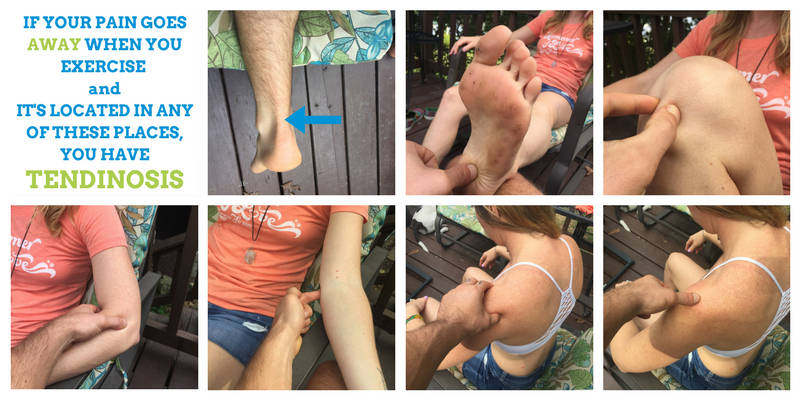
13 Oct “But my pain goes away when I exercise?” All About Tendinosis
The worst kind of problem is the one that doesn’t look like a problem (like tendinosis).
It makes you pause, observe for a second, before moving on.
Kind of like the tip of an iceberg.
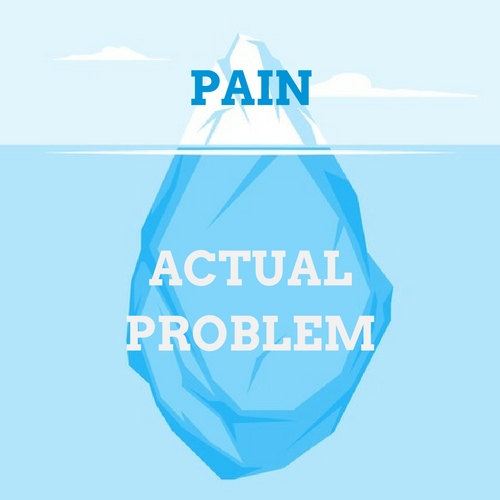
Example #1: If the staff on the Titanic knew that those iceberg tips meant a massive icecube was underneath the surface, we wouldn’t have this…
Example #2: I was miserable in college, so I drank vodka straight by the cup. During a few semesters, I blacked out or peed on my computer as much as three times per week. When I sobered up, the torment came back, so I drank more. Until it occurred to me that I couldn’t drink beer 24/7 and my emotional pain was only getting worse. Then, when it was really bad, I decided to change my thoughts.
Example #3: There’s a reason why home inspectors inspect your home. It’s to tell you where there’s a risk of problems happening. When our fire inspector told me that our grill was too close to the house, I remember thinking:
The grill has a top for a reason and looks comfortable where it is.
Until our little, rambunctious, Sweet Pea decided to lick the grease tray under the grill while I was grilling. When she burnt her nose and knocked over the tray, the whole BBQ went up in flames.
This is Sweet Pea diving through the mud.
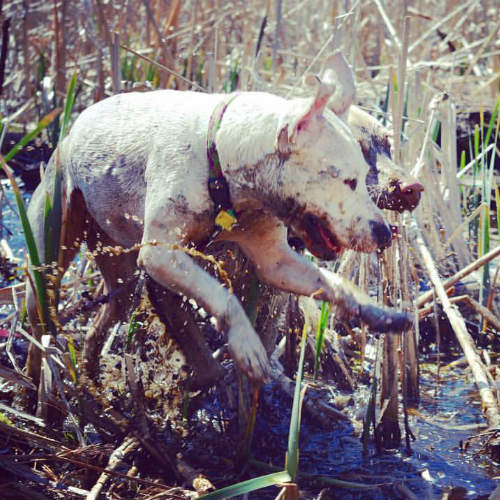
Luckily, we had a fire extinguisher nearby and our home still stands.
When the fire is in your body, it’s way more dangerous.
“But my pain goes away when I exercise?”
This conversation happens way too often in our office at Barefoot Rehab or even outside of the office.
Either because you:
- Run into me at a dinner party and want to tell me about your minor, weird ache you hardly feel, like sitting or getting up from bed in the morning.
- Are a patient in my office and I have to tell you to stop exercising because your pain is getting worse.
Talking about this so often made me wonder, why do so many people let the pain grow until the problem is much harder to fix?
I’ve realized two things:
- You don’t realize you’re doing more harm. Because the pain goes away during exercise, you don’t realize you’re increasing the pain after exercise and increasing the size of the problem.
- You really like working out. In fact, exercise is your only form of stress management.
The purpose of this post is to help you understand why it’s so dangerous to continue working out, especially when you have pain in one of the specific locations we’ll discuss below.
There’s one word you need to learn about: Tendinosis.
Not tendinitis. Tendinosis.
Tendinitis is an:
- acute (happened between 1 hour to 14 days ago) form of …
- overload (doing too much) …
- that resulted in inflammation (usually in the form of pain, swelling, or redness).
If there are no other problems and you take stress off of your injury, tendinitis can go away on it’s own.
Tendinosis is a:
- chronic (has been happening over years) form of …
- overload (doing too much) …
- that is resulting in degeneration of the tendon.
A healthy tendon looks like the window in a box of spaghetti. Notice all of the fibers are going straight up and down.
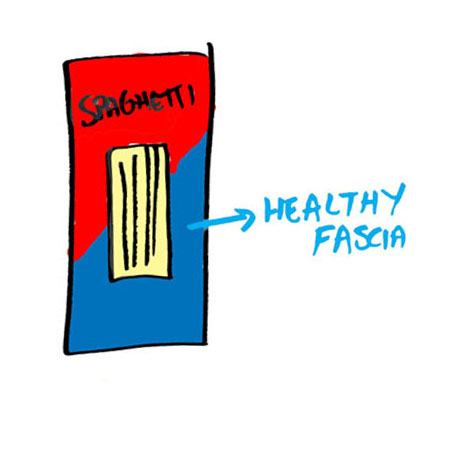
A tendon with tendinosis looks like you poured the spaghetti out on the ground. “Degenerated fascia” is another word for tendinosis.
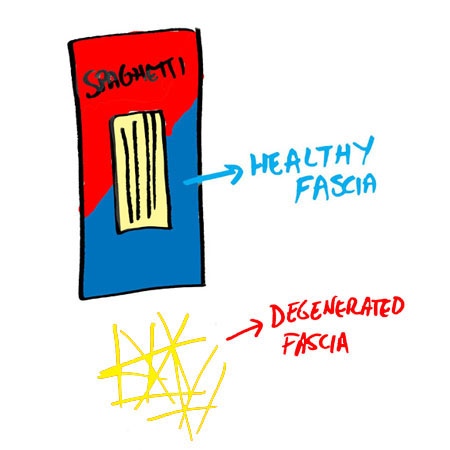
If your pain is in a tendon AND goes away when you exercise, you know, with 100% certainty, that you have tendinosis.
Is Your Pain Here?
The hallmark symptoms of having tendinosis are the:
- pain that goes away during exercise in the early Phases of Pain, combined with …
- the location of your pain.
If your pain is in any of the following locations, then you have tendinosis.

Keep reading to see which tendon is located at these locations.
Then, you’ll see flexibility tests to determine how damaged the muscles around the tendon are.
Why is Tendinosis So Bad?
There’s a famous surgeon named Robert Nirschl who came up with the Phases of Pain for tendinosis. His specialty was operating on elbow tendons.
Nirschl’s Pain Phases tells you how bad the tendon is based on when you feel the pain, letting you know how far your tendon has been damaged.
Below are Nirschl’s Pain Phases for Tendinosis:
- Phase 1: Mild pain after exercise, resolves within 24 hours.
- Phase 2: Pain after exercise, exceeds 48 hours, resolves with warm-up.
- Phase 3: Pain with exercise that does not alter activity.
Notice, the first three phases above allow you to continue exercising.
Continuing to exercise (or use) a degenerated tendon only moves the Pain Phases in one, obvious direction.
How Tendinosis Gets Worse
Another 100% certainty, besides knowing tendinosis is the problem you have, is that continuing to use a degenerated tendon will make it worse.
Hopefully, it’s obvious to you that a degenerated tendon that has been present for months to years won’t get better on its own.
The last four phases of Nirschl’s Pain Phases are:
- Phase 4: Pain with exercise that does alter activity.
- Phase 5: Pain caused by heavy activities of daily living.
- Phase 6: Intermittent pain at rest that does not disturb sleep, and pain caused by light activities of daily living.
- Phase 7: Constant rest pain and pain that disturbs sleep.
- Pain phases 5, 6, and 7 indicate increasing percentages of permanent tendon damage.
Typically, surgery happens at Phases 5-7.
The cool part of these phases is that as your pain worsens after exercise, when you see me at that dinner party and we talk about tendinosis, I can give you a really healthy dose of perspective.
A doctor like me can say, objectively:
You were at Phase 1-2 of tendinosis. Now, you can see you’re at Phase 3-4. If you continue exercising, you’ll enter Phases 5-7 where the only potential solution is surgery with all of its risk. You’re on a path towards greater damage. How far do you want to take this?
Since tendinosis is such an easy diagnosis to make when you understand what it looks like, you’ll believe me and respect your body more than you’ve been doing in the fast.
Hopefully, you’ll want to fix your tendinosis.
How to Fix Tendinosis
Fixing tendinosis does not mean getting a treatment so you’re pain-free for a few days, then having the pain come back again.
If you don’t take all of the necessary steps, you’ll never be able to do what you want to do with that tendon again.
Fixing tendinosis means doing everything you need to do to get better, removing all of the problems contributing to your diagnosis. It means becoming pain-free, for the rest of your life.
Think of your diagnosis like a puzzle. In order to win the game, you need all of the pieces to your puzzle. Miss a piece and you can never win.
Here are the most common pieces of the Tendinosis puzzle:
- Overload – You have been doing more than this tendon can handle for a long time now.
- Adhesion – If your range of motion is restricted, you have relevant adhesion.
- Degenerated (and Granulation) Tissue – “Granulation” is a fancy word for “not-healing.”
- Weakness – If you were strong enough in the first place, your tendon wouldn’t have weakened.
You need to know right now that the healing path is not going to be as short as other patients. It can take months, or even years, depending on how far you’ve damaged the area. However, you really have no choice. The other option you’d be choosing is an inevitable tear and surgery. And no surgery is 100% effective.
To speeden your healing as much as possible, you need to pay particular attention to one puzzle piece.
By far, the puzzle piece that prevents someone with tendinosis from healing as quickly as he/she would like is Puzzle Piece #1 – Overload.
You must rest.
With all of pieces in front of us, we can look at all of the locations where tendinosis occurs.
Does the pain in your Achilles tendon or plantar fascia go away when you exercise?
Easily, the two most evil locations to have tendinosis are in the Achilles tendon and plantar fascia.
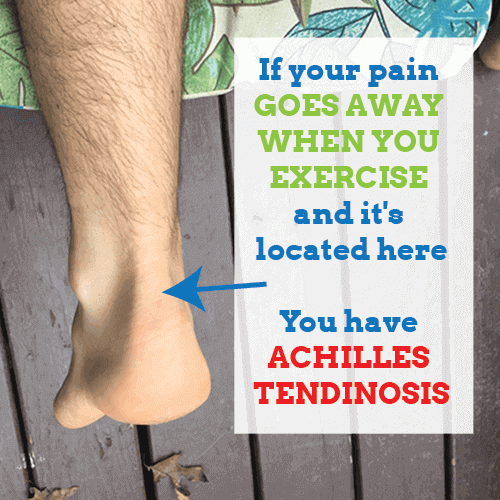
97% of Achilles tendon ruptures occur to tendons with tendinosis first (Source). Isn’t that an amazing statistic?
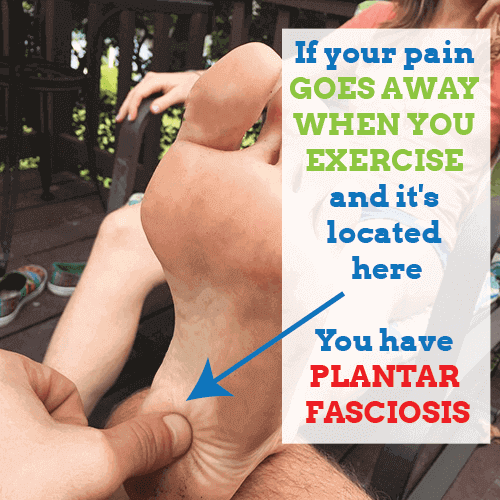
They’re both really evil because as a human being, when you’re not sitting or lying down, you’re on your feet.
And when you’re on your feet, you’re putting more stress (remember when load exceeds capacity, you don’t heal) on these body parts.
I wrote about why your pain isn’t achilles tendinitis or plantar fasciitis and why conventional treatments often fail both of those problems.
You can see how bad your achilles tendon or plantar fascia are with the Knee to Wall Test. You need 6″ of flexibility. The more restricted both of these tests are, the more relevant adhesion is to your tendinosis.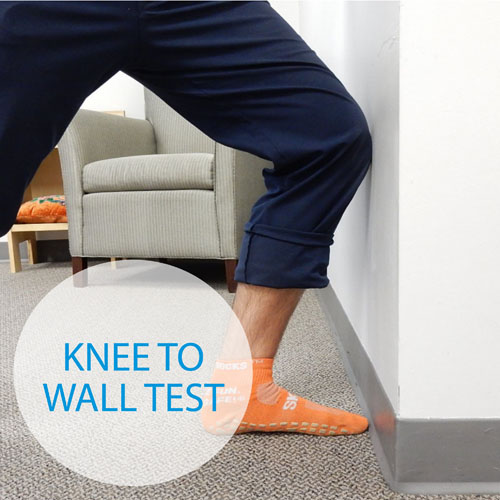 You should also be able to kneel with your butt on your heels. If you can’t there could be adhesion in your knee or the front of your shin/ankle. There could also be arthritis in your knee or ankle. A reputable pain doctor can help you figure out which one is your problem.
You should also be able to kneel with your butt on your heels. If you can’t there could be adhesion in your knee or the front of your shin/ankle. There could also be arthritis in your knee or ankle. A reputable pain doctor can help you figure out which one is your problem. 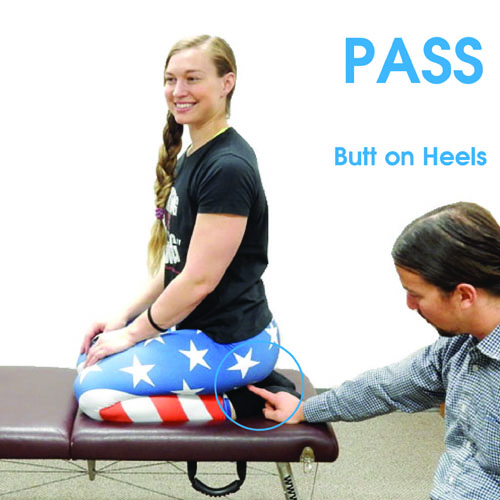
Does the pain in your patellar tendon go away when you exercise?
The patellar tendon is right underneath your knee cap.
Your knee joint is deep to the patellar tendon. This is one location where you need to be really picky about how superficial or deep your pain is.
If your pain is between my fingers below, it’s safe to say you have tendinosis. Degenerated tendons that are overused will be tender to the touch.
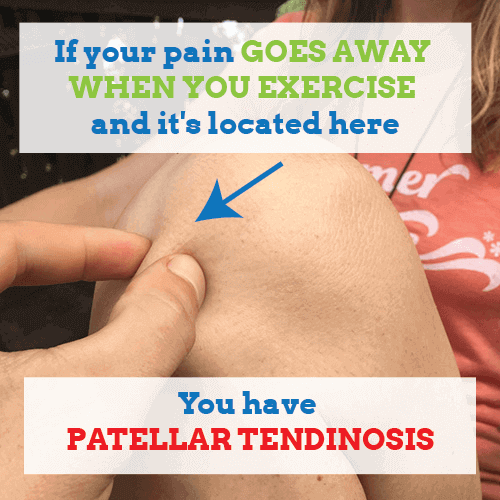
But if the patellar tendon is not tender and your pain feels deeper, then you probably have osteoarthritis. This is more common in people over 50 years of age. Osteoarthritis is a type of pain that will also go away with exercise.
If you do have tendinosis, see how bad your patellar tendon is with the Face-Up Heel-to-Butt Test. Your heel should touch your butt. The more restricted it is, the more relevant adhesion is to your tendinosis. Or, if you’ve ever damaged your knee and you have pain behind your knee or in your calf, then you may have Wallet-in-Door Syndrome. The greater the restriction in this test and the older you are, the more likely your pain is caused by osteoarthritis.
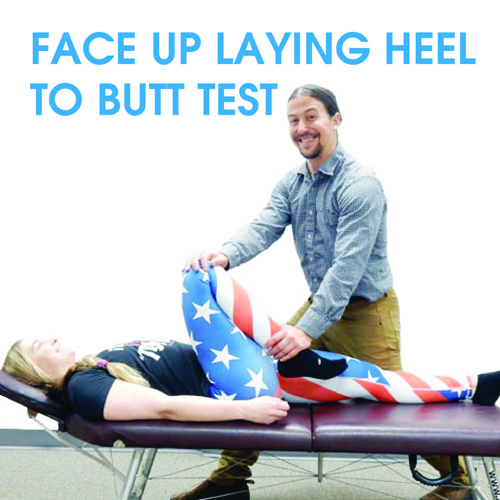 If you pass the Face-Up version of the Heel-to-Butt-Test, then you can continue testing and find out of your quads have adhesion in them, contributing to your patellar tendinosis.
If you pass the Face-Up version of the Heel-to-Butt-Test, then you can continue testing and find out of your quads have adhesion in them, contributing to your patellar tendinosis.
Do the Face-Down Heel-to-Butt Test. This test will be more sensitive for the patellar tendon and quads, assuming you’re younger and/or don’t have osteoarthritis. You’ll need a friend to help you keep your heel on your butt (see the right hand below) while lifting your knee 3″ off the table (see the left hand below).
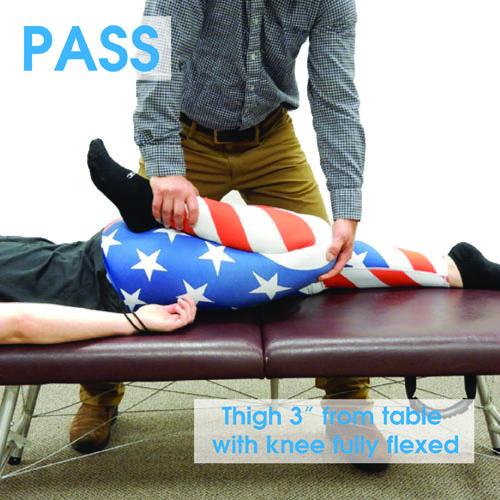
Does the pain in your elbow go away when you exercise?
Elbow pain is common with people who work with their hands or who type all day.
Conventionally, pain on the inside of the elbow is called “Golfer’s Elbow.” This is diagnosis is not specific enough to get out of pain.
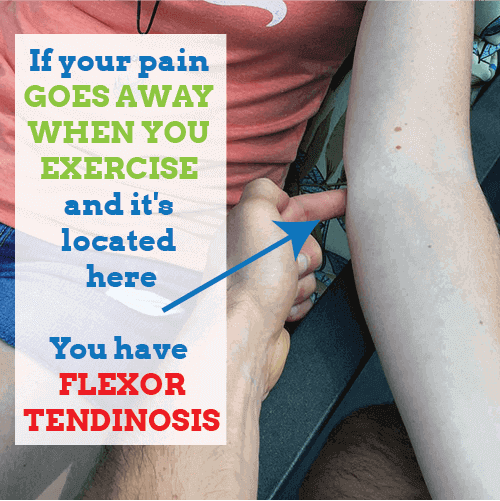
Conventionally, pain on the outside of the elbow is called “Tennis Elbow.” This diagnosis is also not specific enough to get out of pain.
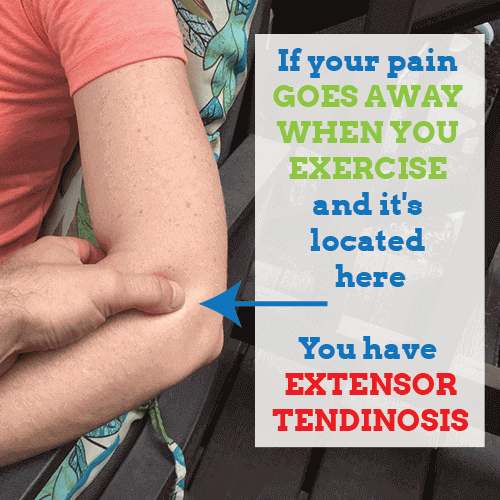
See how bad your elbow pain is Wrist and Finger Extension Test. Your fingers need to get to 7:00 to pass.
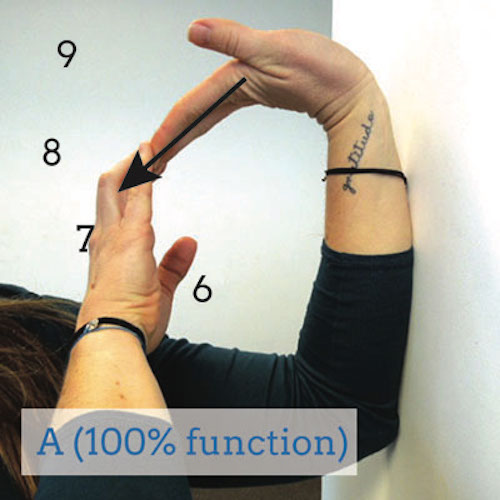
Unfortunately, the human body was made in a way that there is no way to test flexibility for the muscles attaching to the extensor tendon. You’ll need a reputable pain doctor to feel the muscles to see if there is adhesion present in the back of your forearm.
Does the pain in your shoulder go away when you exercise?
Pain in the shoulder can pop up anywhere.
If it’s in the back of the shoulder and it goes away during exercise, it’s probably the infraspinatus tendon. A doctor like me would confirm this by feeling the tendon and asking you:
Is this where your pain is?
Is it tender right now?
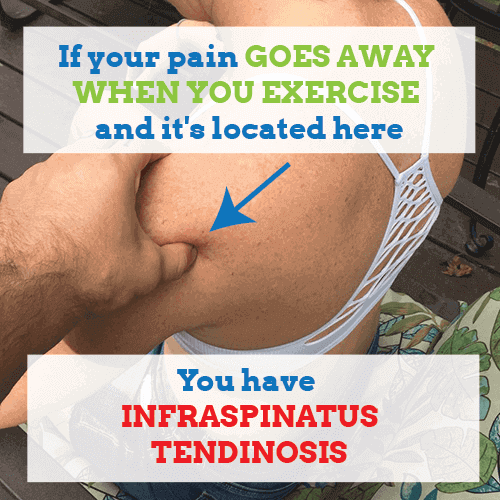
The shoulder muscle most likely to tear is the supraspinatus tendon, seen below.
If you guessed that tears usually happen to degenerated tendons, you’d be correct. : )
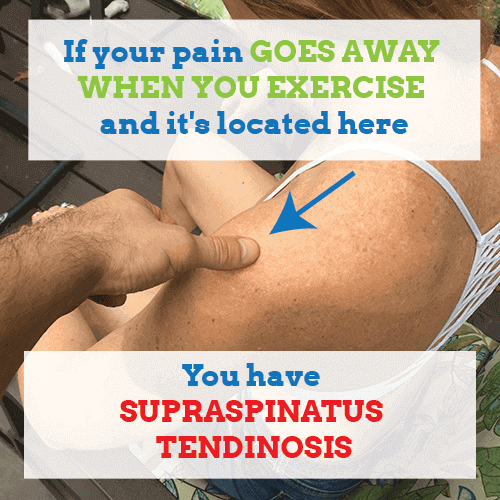
See how bad your shoulder flexibility is by bringing your arms as close to your ears as possible. The more restricted this test is, the more relevant adhesion is to your tendinosis. Watch the below video to see how a patient of ours, who had 10 years of frozen shoulder and had surgery 3 times, had 90% less pain in 7 treatments as her shoulder flexibility increased.
So Stop Exercising and Get Fixed
You are welcome to continue exercising.
Just don’t expect this problem to feel better over time.
Putting stress on damaged tendons is guaranteed to make it worse.
I highly recommend that you get it fixed as soon as possible.
If you want to get your tendinosis fixed, then consider finding an Integrative Diagnosis Provider. Or if you live in Northern New Jersey, call us at Barefoot Rehab.
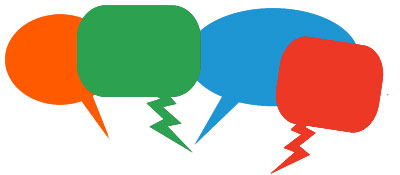 What has your experience been with tendinosis? How long were you in pain before you sought help? How long did it take to fix your pain?
What has your experience been with tendinosis? How long were you in pain before you sought help? How long did it take to fix your pain?


Matt Bowen
Posted at 13:47h, 18 AprilDr Chris.
I am so grateful for finding this article. I have had foot pain for over 12 months and suddenly I couldn’t sit on my heels. However when I ride my bike I am pain free afterwards until I start walking again.
Everyone has been mystified but you may well have shed some light on it Thank you
Dr. Chris
Posted at 14:25h, 18 AprilHappy it was helpful Matt.
Matt Bowen
Posted at 09:10h, 19 AprilSo if my pain goes away after I cycle, should I stop cycling?
Dr. Chris
Posted at 11:09h, 19 AprilI need more data.
When exactly does the pain go away and exactly when does the pain come back?
GO AWAY:
– a few mins after starting to cycle? (I assume)
COMEBACK:
– 10 mins after finishing cycling?
– 2 days after finishing cycling?
Is your pain constant when you walk separate from cycling?
What else makes the pain WORSE?
When did the pain start?
Matt Bowen
Posted at 11:19h, 19 AprilYes pain goes away a few minutes after starting to cycle.
Comes back five to ten mins after starting to walk again. For example, cycled 55 miles on Sunday and felt fine afterwards…went to walk dog half an hour later and then ten minutes into that walk pain started again.
Yes constant pain otherwise, worse after sleep or sitting or standing for long periods.
Pain started 12 months ago. Thank you
Dr. Chris
Posted at 11:25h, 19 AprilWith fairly high certainty, assuming your pain is close to the heel of your foot, you have plantar fasciosis, which is a degenerative condition.
– Is it near the heel?
– how old are you?
– where do you live?
Unless you address it, it is guaranteed to get worse. And foot pain can be nasty when it’s not able to be fixed with conservative care. It affects people’s quality of life significantly.
Not trying to scare you, but I’d rather see you address it now than in another 12 months.
Matt Bowen
Posted at 13:17h, 19 AprilNo I appreciate that. I have been seeing healthcare professionals, physios and podiatrists for the last 12 months and no one has given me a significant diagnosis but I agree with you that everything is pointing to both plantar fasciosis and achilles tendinosis. It has been affecting my life considerably already.
I have pain in the arch of my foot and also at the insertion point of the achilles tendon.
I am 41.
Unfortunately I live in the UK and not near you otherwise I would be booking an appointment with you.
Dr. Chris
Posted at 13:32h, 19 AprilGot it.
Yeah, it’s tough. This type of treatment isn’t new.
Do you know your ankle dorsiflexion Range of motion. Google “Barefoot rehab knee to wall” and test that for me. It would be telling.
I would try the following:
– Graston – bottom of foot.
– ART – deep calf
– Sole Supports – orthotics to take stress off foot.
If these treatments don’t get you progress in 1-2 months, consider flying out to New Jersey for a month to get it fixed. I know it’s a BIG ASK, but I’m not sure what other choice you have.
Hope this is somewhat helpful Matt.
Matt Bowen
Posted at 21:38h, 19 AprilHey Chris. Knee to wall test is 4” on left foot and 5.5 on right foot. I also can’t sit on my heels but don’t get pain at the front of my knee when doing that. The pain is in the joint behind. Appreciate all your help so far. Not many practitioners of Art and Graston in the UK unfortunately
Dr. Chris
Posted at 00:18h, 20 AprilI assume the foot pain is in the left foot?
4″ is 64% function (36% room for improvement by removing adhesion) and 5.5″ is 92% function (8% room on that side).
The pain is behind the knee? That’s a very probably knee meniscus problem.
That stinks. You can play with any really good myofascial massage therapists or ROLFers, but I wouldn’t be very confident in the odds. That’s just me.
Matt Bowen
Posted at 07:12h, 20 AprilBoth feet have pain unfortunately. Left foot mainly the Achilles and outside 5th metatarsal and right foot is the plantar pain with a little Achilles. Right leg has the knee problem. Not sure how it all happened like this. Appreciate your help
Dr. Chris
Posted at 12:16h, 20 AprilI hear you brother. I’d definitely get Sole Support orthotics. You will degenerate slower with them.
Mike McGill
Posted at 13:54h, 16 MayGreat information! Sounds like this is what I’m dealing with. Though mine is front shoulder (on both). I had an MRI and they are figuring impingement on the bicep tendon due to “lack of room” in my shoulders, possibly from rounded shoulders. They prescribed more PT and then possibly surgery. I’m going to get a second opinion. Wish I lived closer to New Jersey!
Dr. Chris
Posted at 13:58h, 16 MayCould be biceps, more likely to be supraspinatus tendinosis. Good luck Mike.
Jason Fredrick
Posted at 20:41h, 30 MayMy Army Dr. at Ft Bliss, Tx had an xray of my ankle done. It showed my Achilles tendon had “calcified”, he called it Insertional tendonitis. The pain is horrible at the base of my heel when running, however cycling isnt painful during or after. Is that normal?
Dr. Chris
Posted at 21:01h, 30 MayHi Jason, some calcifications can resorb with rest and treatment to remove adhesion from your calf and feet. Others cannot and may need surgery. Does the pain get better after a few minutes of running? If yes, then it’s tendinOSIS (not tendonitis). If it just gets worse, then yes, it’s a form of tendonitis. Of course, this pain isn’t normal. Cycling puts less stress on your achilles tendon when compared with running, so this part makes complete sense.
daniel chuaire
Posted at 15:41h, 22 JuneHi doctor Chris thanks for the greatest info I have found online, I’m pretty sure I have quad tendinosis (above the knee) i was on the stage that pain was going away with exercise keep doing like 2 months, now I’m on the stage I cannot do a squat without feeling pain
, I’m desperate I’m crossfit athlete and coach and now suddenly I have to stop squatting, i can’t demo a single squat, I stopped completely squating for like 3 weeks, and havnet seen any reasonable recover happen, what would you recommend to do, I’m going to see the pt next week and start 2 sessions per week. Again thank you for your knowledge.
Dr. Chris
Posted at 17:51h, 22 JuneI’m sorry for your struggles Daniel.
You need to get all of your lower body joints measured:
– Straight leg raise
– Hip flexion
– Hip extension
– Knee flexion
– Ankle dorsiflexion
– Ankle plantarflexion
If treatment doesn’t make the range your PT is working on better in 3 treatments, find a new PT. You can find these tests, the way we do them,
Keep me in the loop. I’m here for you.
Jackie Batchelor
Posted at 20:48h, 05 JulyI play golf usually daily, I am right handed and when I am not playing my right shoulder and now my bicep on the outside almost brings tears to my eyes. I have some knots in my right arm below the shoulder beside my bicep. At night I cannot sleep much due to the pain. Any thoughts on my problem?
Dr. Chris
Posted at 21:22h, 05 JulySounds like “arthritis” of the shoulder. It could be tendinosis, but the location sounds like “referral pain”, not rotator cuff. Night pain is consistent with arthritis as well. Does your arm hurt when you bring it overhead? First step would be to get an MRI or find someone who fixes adhesion.
Josh
Posted at 17:17h, 06 AugustHi Chris, I have ankle pain on the top of my ankle after a few hours of walking. Goes away within 30 min. Also goes away with explosive running or toe extension with body weight. No pain in the mornings or with rest. Just stiffness when I wake up from a hard day on it . The area of pain is left ankle left top of ankle. I can go longer the more I rest
Dr. Chris
Posted at 18:30h, 06 AugustHey Josh, it sounds like a low-level “arthritis”. The better you manage NOT putting excessive stresses on it, removing all adhesion, and letting muscles recover, the longer you will able to continue exercising. If you don’t wear Sole Supports orthotics, I’d start as this will give you an extra 5 years of activity (that’s my arbitrary guess). Have you checked your Knee to Wall test numbers?
Jamie Jones
Posted at 18:04h, 25 AugustHey there, I think I have tendinosis but im not sure because the location of the pain doesn’t match any of those mentioned above, The pain is in the elbow but not on the outside or inside of the boney part, its more in the center of the elbow below the bicep, the pain subsides when I do a few bicep curls and only hurts when under load or I supinate my wrist and the pain feels like somewhat of a pinch most of the time, the pain isnt extreme at anytime, it never aches or just randomly hurts on its own and has been this way for around 2 months, to be honest, I decreased the load and for the past three weeks the pain associated with those movements has drastically reduced, I think it’s healing on its own whatever the problem but I just think it’s weird because given it’s location it dosent seem to match tennis elbow or golfers elbow though the symptoms match those of tendinosis.
Dr. Chris
Posted at 18:33h, 28 AugustHi Jamie,
I’ve never treated this myself. But you may have “pronator teres” tendinosis. You can google pronator teres to get an idea of where this is located. Good job resting it. If it lingers into the future, you know what you can tell someone who does soft tissue work. : )
Kishan Patel
Posted at 02:46h, 22 OctoberHi Dr.Chris, thanks for all your efforts in helping people with chronic tendinosis. I’m only 23, but I wake up every day with fairly stiff ankles, noticeably when I’m brushing my teeth. By the time I’m out of the shower they feel okay, nothing too noticeable. This has been the case for a year now, and it doesn’t seem to be getting worse OR better. I’m gonna follow your advice and buy custom orthotics, but I’m not sure what else to do. I did the wall test, and I was able to just barely touch the wall at ~4 inches away, feeling a strong stretch in my achilles area. Does the way I sleep have any impact? I sleep on my stomach so my foot is elongated when im sleeping usually.
Dr. Chris
Posted at 11:59h, 23 OctoberKishan, please make sure they are SOLE SUPPORTS orthotics. You can find a provider through their website. I would not recommend any other product.
4″ is 64%. That’s pretty bad.
Probably not sleep. But try to sleep on your back or side and then you’ll know in 24 hours.
Have you had any injuries to the area? Trauma?
Has anyone diagnosed it?
Where is the location of the stiffness? If it’s inside the ankle, it’s more likely cartilage or arthritis, not tendinosis.
Kishan Patel
Posted at 16:10h, 10 NovemberArthritis at 23 that’s real sad. So is it okay for me to still squat, lift, weights, run, etc.? Do you know where I should go to get a diagnosis?
In terms of injuries, not particularly. I wore Toms shoes for a while which are terrible, and there was one weekend where my achilles and my ankles were hurting a lot, and I had to walk a ton the entire weekend (like probably 15-20 miles). After that I wore better shoes, rested, etc. but I never got back to 100%.
What do you mean by cartilage? Like cartilage degradation –> arthritis? If so, is there any way ill be at 100% again or is it only downhill from here
As for where the location of the stiffness is, i can’t tell if its ‘inside’ my anke. I’ll try and see tomorrow morning
Dr. Chris
Posted at 14:24h, 12 NovemberHi Kishan,
It is sad, but if it’s the reality, the only question becomes, “How do I live the rest of my life with as much freedom as possible?” Some of us have genetically weaker cartilage or discs (while others have weaker hearts or immune systems). So, it could be worse.
Generally, anything that increases your symptoms during or up to 72 hours after an activity is putting further stress on the damaged area and speeding up arthritis. Getting fixed can give you more ability to do what you want.
Check out “Integrative Diagnosis find a provider” on google. This is your best shot.
Yup – 20 miles in Toms can be traumatic.
Yes, cartilage = arthritis.
Arthritis can get better with exercise or activity too. The LOCATION is the determining factor if it’s tendinosis or arthritis. Tendinosis happens IN TENDONS.
Kishan Patel
Posted at 02:47h, 22 OctoberMy strong suspicion is that its tendinosis, because the pain certainly goes away when I exercise.
Dr. Chris
Posted at 15:54h, 24 FebruaryYup, sounds right Kishan.
Sierra Swords
Posted at 16:01h, 12 FebruaryHello,
I recently got back into running after chronic pain made me stop during college. After upping my mileage to about 100 a month, I’m starting to feel the same pain again that made me have to stop in college. back in college I had gone to PT for a few months and finally the guy told me he had no idea what was wrong with me and the pain never got better until I just stopped running altogether. I feel fine during running but afterwards when my body cools down and especially the next morning when I first step out of bed and put pressure on my feet, I feel a pain across the tops of my feet. When it gets really bad it even goes up a little into the front/side of my leg. I did some googling and thought it might be extensor tendonitis but I don’t feel pain during the runs. Any idea?
Dr. Chris
Posted at 15:54h, 24 FebruaryYes, sounds right. But we need more information. Record your lunge technique and send to me. Also, measure dorsiflexion https://www.barefootrehab.com/know-your-numbers-ankle-pain-foot-pain-and-ankle-dorsiflexion/). Do this to start Sierra.
Abhi Kumar
Posted at 04:45h, 04 AprilBrachoradialis pain occurs during hammer curl, reverse curl 1st set only. After that, no pain during later sets, no pain rest of the time. Only 1st set gives pain. How long should I keep away from exercise?
Dr. Chris
Posted at 10:50h, 12 AprilSorry for delay Abhi. Mmmmmm. It doesn’t matter. It’s tendinosis. It won’t get better without treatment because the spaghetti is out of the box. So keep working out and manage the pain consciously or get fixed.
Ger
Posted at 11:35h, 03 MayHey Chris
This comment appears on another blog, but it’s for this one!
I’m 50, got back in ok condition over the past 10yeats, but recently (6 months) started squats in the gym. Nothing crazy.
Past few weeks I get stiffness and slight pain standing up, climbing stairs etc., especially in the morning. Eases off after warming up, even just walking about, but can feel a little tight after the gym when doing ADLs.
I’ve dialed down the squats past few weeks (body weight only, eccentric wall squats, Spanish squats), and back on the road bike now it’s warmer (I live in Ireland, so it’s still wet)!
Am I on the right track? I think ‘rest’ will just lead to more stiffness and I am looking to find the right way to stay fit & strong but deal with this ?tendinosis.
Oh, should also say I am prone to inflammation (elbow, Achilles, hips) but find stretching loads, strengthening, hot and cold treatments and keeping moving really helped.
Your website as been a good find too.
Looking forward to your advice. Many thanks!
Ger
Dr. Chris
Posted at 16:32h, 03 MayWhere is the stiffness and slight pain?
Ger Maley
Posted at 17:15h, 03 MayJust above my knee caps and lower quads. Occasionally further up my right quad, centre.
G
Dr. Chris
Posted at 10:06h, 07 MayYeah, that’s good news. Likely quadriceps tendinosis and not osteoarthritis. I’d still get someone to work the adhesion out of the quads. You may also want to make sure your hamstrings and glutes are strong. Can you lunge and land on your heel and push off your heel? (https://www.youtube.com/watch?v=kdx1OIE_lYo)
Gerry
Posted at 08:17h, 09 MayThanks for reply Chris.
Yes I can do that, not as athletic as you, but I’m guessing you’ve got an age advantage. Can land and push from heel & don’t think my knee collapses in.
Actually felt good, should I encorpirate that with wall sits (warm up) and Spanish squats as my rehab??
Should mention probably have osteoarthritis in my L knee. But at my age and after lots of field/ball sports and at least one cartilage tear, to be expected.
Dr. Chris
Posted at 10:52h, 09 MayHa – the younger someone is, the less likely they have joint damage. You’re right. BUT EVERYONE needs to be able to do a lunge. It’s like saying, “Just because I’m younger, I should have lower blood pressure.” We all know we need low BP to minimize risk of heart attack. So keep working on lunges. If this doesn’t feel right or technique is off, keep feet stationary with and do a split squat in a half range of motion til it gets stronger. Wall squats and Spanish squats are OK – they’re just not going to translate to “WALKING” as well as lunges or split squats will.
Gerry
Posted at 11:29h, 09 MayThanks! I’m in ok shape for my age, and I intend to keep moving. Thanks again. G
Gerry
Posted at 07:48h, 11 MayThanks again Chris. The lunges are good. Left knee cap a little bit sore after, but I’ll monitor that and adjust as required.. I agree about age, and that we all need to keep moving. I am fitter, stronger and more flexible than I was 10 years ago as a result of lots of hard work, that I enjoy. A few bumps on the road (herniated neck disc, various aches and pains, and definitely some tendonosis in knee and also ankle) but I believe we were made to move and love and both bring challenges but we need to keep going!
Thanks again, your website is great.
Peace. G
Raghav Mudgal
Posted at 15:31h, 03 MayHey I am experiencing a pain in my upper left arm and shoulder and right back. But all these pain go away after exercise or unning for more than 5 km.
Dr. Chris
Posted at 16:33h, 03 MayThose locations aren’t too specific so it’s hard to say what’s going on. Are there any shoulder or neck ranges of motion that provoke the pain?
Raghav Mudgal
Posted at 14:50h, 28 DecemberYes the pain increases when I am sitting or am idle or when I am in bed with belly facing the roof (I experience pain in my upper left arm only) which goes away when I wake up in the morning again. However the pain mentioned in the areas increases as the day moves on (if I don’t exercise on some days).
Dr. Chris
Posted at 00:45h, 28 JanuarySorry for delay. If pain happens when you’re idle, it’s pointing at nECK!
Dr. Chris
Posted at 12:32h, 11 MayYou should be proud of yourself Gerry. Keep going mindfully. <3
Russell Chase
Posted at 16:05h, 22 MayHi Chris! I have had semitendinosus tendinosis. It’s been over 18 months. I’m in Phase 5-7. I’ve been told to perform eccentric exercises, but it only temporarily relieves pain like this article states. I would pay for a consultation over phone or video chat. I am 25 and ran for New Balance at the time of the initial injury.
Dr. Chris
Posted at 21:20h, 22 MayHi Russell,
Yeah, eccentric exercises are only a part of the diagnosis, addressing the tendinosis part. If you have adhesion in the sciatic nerve or hamstring, no amount of hamstring strengthening will work.
We can do a consult, but you would need manual therapy to actually get fixed. Where do you live? Or are you just looking to discuss this issue?
Megan Brownell
Posted at 22:37h, 31 MayI’m a 44yo woman, fit and active, with chronic tendinosis in both shoulders, both feet, both elbows (both lateral and medial) and where my triceps insert into my elbow. This started about 3 years ago with the shoulders, followed by the feet, followed by the elbows and triceps. (There is a possibility this is induced by flouroquinolone antibiotics I took 4-5 times between 2014-2016; my doctor also just ordered labs to check for autoimmune disorders). I’ve done PT, OT, dry needling, prolotherapy, ice every night, eccentric exercises every day. The one thing I haven’t done is REST. I have to work at a computer most of the day and I work out 3x/week: strength training for 30 mins with a personal trainer, who has been great at modifying exercises and trying to help me through this, and 30-40 mins cardio, switching between treadmill, elliptical, stepmill and stationary bike. After reading your article, I’m realizing I may need to completely stop exercising for a period of months if I want any chance of my tendinosis healing (I can’t stop working, which doctors have also suggested, but that’s laughable). This makes me so sad because I love lifting weights and I’ve gotten really fit and strong over the past 2 years; I don’t want to lose all of my progress. Is there ANY form of exercise I can do without making my widespread tendinosis worse? Yoga, pilates, swimming, anything? I’d love any recommendations you have.
Dr. Chris
Posted at 07:45h, 01 JuneHi Megan, if you actually have “tendinosis”, YES, rest will be necessary. You can’t keep putting stressed on degenerated tendons and expect them to heal. Also, getting rid of adhesion is super important to heal. Then, eccentric exercises come after that.
As far as exercise, you can do anything that DOES NOT provoke your symptoms in any way during or up to 72 hours after a workout. If you do provoke symptoms, you’re making your tendinosis worse.
Swimming is likely the safest bet.
Remember, this is a long ball game. I’d rather see you fit as an old woman at 70 years old than workout hard for a year or two and not be able to do it again.
Gerry
Posted at 21:57h, 12 JuneHi Dr Chris
Ger again. Had to switch back to static lunges as dodgy old knee with no cartilage left (osteoarthritis) was complaining
Between those and Spanish 8 wall squats, most days are better (using pain inducing test, slanted board under feet to check) gone from a 5ish/10 to 3 or 4 and some days less. Steady progress. BUT not in the morning. Very stiff and quite sore standing up out of bed…most days the same with occasional improvements, should I be concerned? I am excercising most days, do I need to dial that down? How long will significant improvement take? Thanks Chris! Ger
Dr. Chris
Posted at 22:10h, 12 JuneARE YOU still stiff and sore out of bed after days that you DO NOT do these exercises? I’d experiment with resting a bit more or put more LOW LOAD exercises into workouts and see how you are waking. You want to minimize stiffness in the mornings. So keep experiementing.
Mild -Moderate improvement with exercise should take 2-4 weeks. If you have adhesion, progress will be limited.
Gerry
Posted at 18:21h, 13 JuneI’m be been doing wall sits nearly every day and Spanish squats 4/7. Another problem is I have to drive c.4hrs most days. Unavoidable. It’s hard to establish a cause and effect pattern, except I’m virtually pain free when I test in the afternoon most days regardless of what I’ve done that day or the day before, so that seems like progress. When rising it’s helped if I’ve stretched the night before but otherwise it’s from 4 to 7/10. I’ll take more rest (walk or swimming) and start more loaded wall sits or Spanish squats 2 or 3/7. Also I think cycling helps? Is that counter intuitive? Then I’ll try to track it better. Thanks for the advice again. Best. G
Dr. Chris
Posted at 21:20h, 13 JuneYeah, I doubt the cycling is helping. But if it doesn’t increase the pain, then you can keep it. Here for you.
Gerry
Posted at 04:28h, 14 JuneThanks Dr Chris. Got up this morning with much reduced pain. Was there but better. And guess what, I’d a good workout Two days ago, but rested yesterday…maybe I need to think about that! Peace brother. G
Gerry
Posted at 07:37h, 17 JuneWill foam rolling help muscle adhesions to get better? Or stretching? If I can’t find a manual therapist will strengthening fix my tendons, so long as what I do doesn’t make the pain worse the next day? G
Dr. Chris
Posted at 19:58h, 02 JulyHi Gerry, No. You need a TENSION force to break adhesion and inflame a degenerated tendon. Yes, strengthening should help as long as it doesn’t increase any symptoms.
Andreas K
Posted at 17:12h, 05 JulyHello. I’ve been lifting for 4,5 years and last September it started to feel pain in my left shoulder. I Visited a physio and followed a programme while I continued to work out except of performing presses until I gave up every exercise on December because it got worst. I had an MRI that showed supraspinatus tendinosis and then I had some PRP injections and lots of visits in the physio. It got a little bit better, but two kilos are enough to flare up that tendon. I got desperated. Is there anything i can do? Thanks in advance.
Dr. Chris
Posted at 00:33h, 06 JulyFirst, if you got the injection into the tendon, shame on the ortho. If it was into the joint space, fine. But it won’t help the OSIS. I’d find a Manual Adhesion Release doctor near you. At this point, it’s your logical next step.
Gerry
Posted at 16:59h, 14 JulyThanks Dr. Chris. Does TENSION force = Manual Adhesion Release? G Force
Dr. Chris
Posted at 20:04h, 14 JulyTENSION force doesn’t equal Manual Adhesion Release. However, MAR is a treatment focused on tension, therefore, it delivers the best treatment for chronic pain (I’m biased).
Rhiannon
Posted at 06:15h, 25 JulyHi Dr Chris, I have recently been diagnosed with glute med tendinosis with tears as well as tears and tendinosis in hamstrings and adductors. I keep trying to find more info online regarding this and how to treat but I have not had much luck. I know I am not properly resting them as I run around and carry 2 small children. I had been stretching them unknowing I was causing more damage but it was the only sense of pain relief. What can I do to start healing process and lessen the constant pain?
Dr. Chris
Posted at 12:31h, 25 JulyHi Rhiannon, I’m sorry for your troubles. The first step is to stop overusing them. I understand that may be hard to do, but it’s 100% necessary and will be nearly impossible to fix without resting. Next, you’ll have to get all of your ranges of motion checked and have any relevant adhesion removed to unload all of these tendons and muscles. Where do you live?
Rhiannon
Posted at 06:08h, 28 JulyThank you so much for your response. I live in northern alberta.
Dr. Chris
Posted at 21:27h, 28 JulyYour best bet is to find someone who does BOTH ART and Graston. They can use both tools to help it.
Gerry
Posted at 21:05h, 31 JulyI’m confused. I have tendon pain I n both quads and one in Achilles, long term and feels like starting on the other. I also have tendon pain occasionally on the outside of my elbow (used to get ‘tennis elbow’ muscle pain, but not now). I’m trying strengthening, stretching and manual cross frictional self massage, because I can’t find ANYONE in Ireland that will do MAR so far. What should I do?
Dr. Chris
Posted at 23:01h, 02 AugustConfirm a diagnosis first. Does the tendon pain come at the END of activity? This is tendon-ITIS. Or is it there at the BEGINNING of activity? That’s tendon-OSIS. Two different problems. Your 2nd best bet is to find a good manual adhesion doctor and then a good physical therapist or strength coach to fix you after adhesion has been removed.
Chris Edwards
Posted at 22:22h, 29 OctoberGlad to have stumbled on this article and the comments. I’m 45 and started running four years ago. Running has become not only what I do to manage stress and anxiety, it has become part of how I define myself. I recently completed my first half marathon. The last couple weeks of training I started feeling a burning pain above my knee cap. The pain after after a run would last for two or three days. I took the last week off before the race then ran 13.1 miles on race day. It took over a week for the pain to go away. I went to an orthopedic who specializes in sports medicine this week. He said it appears to be quad tendonosis. I feel like I’m stage 5 or 6. He wants to send me for an MRI before taking a treatment direction but he told me I’m done running for at least a couple months. I’m completely bummed out. Finding this article and comment section was almost like finding a support group. I wish all the past and future commentors all the best in their recovery and rehab. I hope with all my might I’m able to run again early next year. I’m not sure what could replace that for me right now.
Dr. Chris
Posted at 00:42h, 28 JanuarySorry for delay CHris. Awesome on getting a good diagnosis! Hope you’ve found relief and that the post has been helpful!
Darren O
Posted at 19:29h, 06 FebruaryHi there, I’ve been dealing with a bit of right ankle pain for the last 5-6 months that initially presented as more of an acute/sharp pain on the side of the heal, but generally when only when foot in plantar flexion position. I’ve taken a couple of 2-3 week breaks, substituting with stationary biking, but it hasn’t fully subsided. Have tried running a bit on it, and similar to other posts, there is very little to no pain while running, but now get a dull burning/achy feeling 2-3 hours after cooling down on side of ankle and slightly up the ankle; usually gone by later in the day or next morning. For context, I did spend too much time doing speedwork in a counterclockwise direction last summer, so have assumed it’s a peroneal issue. Have since just stuck to slower runs on straight routes. The pain in the heel has subsided that was originally there, but now get more of a dull pain across and side of the foot when in plantar flexion. Have read on some sites that completely offloading the tendon (in case of peroneal tendonosis) can be counterproductive, but wanted to get your thoughts.
Dr. Chris
Posted at 20:21h, 06 FebruaryCheck your dosiflexion grade. Report back.
If you dno’t have 6″, you either have adhesion (hopefully) or arthritis in ankle. What’s your age?
https://www.barefootrehab.com/know-your-numbers-ankle-pain-foot-pain-and-ankle-dorsiflexion/
Darren O
Posted at 21:15h, 06 FebruaryHi Dr. Chris, thanks for the quick reply! It’s just at 6″, maybe slightly under. Age is 38. As mentioned, generally only feel the pain on side of foot wrapping a bit over the top when extending/pointing foot in plantar flexion and a bit of dull burn for a few hours after running. I also tend to sleep with foot in stretched plantar flexion (stomach sleeper), so not sure if that’s not helping things. I haven’t had any imaging yet, but not sure what best option would be.
Dr. Chris
Posted at 21:35h, 06 FebruaryHmmm got it. Good news is doesn’t sound like a major problem. But it’s likely a little adhesion or a little arthritis. Where do you live? Are there any adhesion specialists around you?
Darren O
Posted at 21:45h, 06 FebruaryOk thanks for response. I’m actually in Canada, but found this page useful and saw your helpful responses to previous posts. I’ll look into treatment options around me. Worst case, what would a treatment pathway or self-management of arthritis look like in order to keep running?
Dr. Chris
Posted at 02:27h, 08 FebruaryDarren – You want to try to find a good myfoascial therapist and give them 1-5 visits to get you some % of permanent relief. Self-management will be tricky and depend on lots of factors. Its’ very easy to speeden up any arthritis. LMK.
Darren O
Posted at 16:21h, 27 FebruaryHi Dr. Chris – quick update. Had an ultrasound performed 2 weeks ago which indicated the peroneus brevis and longus tendons are intact. A small amount of fluid surrounding the peroneus longus suggests mild tenosynovitis. So generally good news. The foot and ankle specialist recommended a 6-day taper window of oral Medrol, but am wondering if ART/Graston would still be as, or if not, more effective. Given it’s been 6 months, am anxious to get this solved and looking at new options, but not sure if should be worried about potential Achilles problems that could result of that medication?
Dr. Chris
Posted at 00:13h, 28 FebruaryHey Darren! Graston would work best on peroneals and anterior shin. I’d still get someone to check deep calf structures with hands. Yes, achilles is a risk with that. Anti-inflams will help inflammation but NOT the cause of the inflmmation. Also, consider Sole Supports orthotics.
Craig R.Conard
Posted at 21:45h, 19 FebruaryHello my name is Craig . I tore one meniscus it led to some weakness . Than I tore meniscus in other knee . This led to more weakness and weird walking .This cause my foot to stretch planter . More weakness . Now I strained both my proximal hamstrings . This is a lot of pain . I am in PT . They are giving me strength and stretching exercise . They said I need this to get tendons use to a load again . It happen from a sudden overload picked something up and bam , This proximal pain has been a month and a half . I have been in therapy for 9 sessions .It hurts when I stand walk sit .I am very frustrated . can you help . thanks
Dr. Chris
Posted at 22:46h, 19 FebruaryHi Craig, I’m sorry about this. Unfortunately, we see this every single day.
Yes, we can help. We see patients like you everyday who want permanent relief. But not virtually. Where do you live?
Craig C
Posted at 01:30h, 20 FebruaryThanks for the response . I live way to far away to be seen . I didn’t know if they where on the right track for treatment . I know it can take months to build muscle and stamina back .
Dr. Chris
Posted at 17:00h, 20 FebruaryHow far is too far? When someone’s pain is bad, we’ve had people drive from Texas to NJ for help. But LMK where you are and I can see if we have a guy closer to you.
Craig C
Posted at 18:20h, 20 FebruaryWell like I said the pain is proximal hamstring strain from a sudden incident . I am currently going to PT . I am currently seeing a sports orthopedic DR. I also live in MO. Thanks for the feed back.
Dr. Chris
Posted at 18:44h, 20 FebruaryCheck out Precision Health Group in St. Louis. One of Top 3 Chronic Pain doctors in world.
Triceps pec pain
Posted at 08:41h, 29 FebruaryHello sir,i have injured myself at the gym 5-6 month ago, ive taken a rest for 6 month and had taken mris for shoulder,upper arm,elbow and chest, according to mri results theres nothing wrong with these muscles but when i got myself injured i felt a sudden very sharp pain on my shoulder area and since then i have constant unbearable pain on my left pec major, upper triceps muscle and lat dorsi.Two days ago ive began to work out with very light weight, when i workout with biceps my triceps hurts alot but when i workout with triceps my pain goes away, same as pec major.I did pt for 2 month and no real improvement done, i also have seen professional sport injury doc, he told me to start working out since its been 5-6 month.
What is my problem exactly? I cant figure it out, the unbearable pain always stays there no matter if im resting or not.
Dr. Chris
Posted at 11:57h, 29 FebruaryHey there, it’s hard to say. What else makes the pain worse? Sitting? Head down? Sleeping in any position? Bringing arm over to head? Do these 5 neck tests and see if you have any symptoms. https://www.barefootrehab.com/stiff-neck-tests/
It sounds like it’s some sort of moderate-severe joint pathology. Either shoulder or neck. LMK.
TRICEPS PEC PAIN
Posted at 13:16h, 29 FebruaryHello sir, Walking is making triceps worse and sometimes working out the triceps making it worse sometimes making it better, pec major pain is reduces when i take a walk and workout it, From time to time on daily basis i feel sudden sharp pain on my pec major when its idle.My tricep and pec major pain is intense, it feels like a burning pain( sometimes a burning pain that feels like a thin fiber is burning down on my triceps) and sometimes it feels like a muscle pain but the pain is always there.I have tested the stiff neck tests, none of those movements made it worse or better.Sitting down is making my pec major pain worse, i always lay down on my back on the bed and after letting it rest for 15min i turn right on my shoulder to fall asleep and if i find it uncomfortable i try to find a better position.
I am sorry for my english language,its not my native language,im trying my best to explain the situation that im going through for last six month.
Best regards.
Dr. Chris
Posted at 13:38h, 02 MarchYou’re doing great with language. No worries.
It sounds like your issue is complex. No diagnosis fits your presentation exactly. If walking makes your tricep pain worse, that’s not a good sign. Could be lower cervical disc. Sitting making your pec worse is likely a disc unless you’re arm is overextended in front of you at a computer. My most probably diagnosis is a neck disc issue.
Hope this helps.
Peter
Posted at 05:47h, 20 MarchHi Dr,
I have been having right calf pain for like 3weeks now. Feels like it’s always tight but when I exercise or walk the tightness/pain disappear.
The pain started after a rugby game which I had played after staying out of rugby for years.
I had also started doing heavy calf raises afew weeks before the game. Any idea what this might be and how do I take care of it
Julie Johnson
Posted at 01:06h, 29 MayIs it unusual to begin experiencing pain in both knees at the same time? I’m beginning to think I have tendinosis from riding my bike and indoor cycle. It began 2 months ago the day after I rode a recumbent bike for an hour at the gym (not something I hadn’t done before, but not something I did regularly.) The pain started the next day in the front of both knees and has been there ever since. It’s mostly when I bend my knees and isnot bothersome when I’m just walking around. It goes away when I exercise but then comes back a few minutes after. Then maybe a month in my heels began to hurt after rest but that improves as I walk as well. I was beginning to think it’s arthritis but always thought it was unusual that it began in both knees at the same time.
Dr. Chris
Posted at 12:41h, 30 MayHi Julie, no not unusual. Tells me that you’ve increased activity too quickly and will have to back off and more slowly strengthen. Depending on your age, this sounds like tendinosis or osteoarthritis.
John Gweru
Posted at 10:00h, 18 AugustWhat would be my problem, I feel tired in my shoulders and arms for some weeks now. My left shoulder looks like it has a slight swelling when I raise my arm. I used to go the gym regularly till about 4 months ago.
Dr. Chris
Posted at 18:25h, 18 AugustIf it’s in both sides, it’s most likely coming from the neck. If something is swollen, it’s obviously damaged. You should find a shoulder specialist who can diagnose you OR get an MRI to confirm what is damaged.
Richard Clement
Posted at 22:17h, 16 MarchHi
I have a pain on the top of my left calf which joins the knee. I have been told it is a small tendon that joins the knee to the calf. I have had an ultra sound and no obvious damage. This has been with me about 7 months and it only comes on after a run… I get the odd twinge in the effected area but not anywhere near enough to stop. After about 2 hours after the run it starts to hurt nothing major just a bit tight and is a lot worse next day. I have rested it for about 6 months and was completely pain free.. and gradually started running again .. but after about 2 months I have increased my intensity on the runs and it has come back.. does it mean I have loaded it too quickly and why is it running that is causing it only .. I have ran all my life and am now 56. Strange why this area has been effected and I can’t find anyone else with this problem in this area? I am currently running every other day .. but find a long fast run is taking longer to recover?
Dr. Chris
Posted at 23:03h, 17 MarchHi Richard, if you rested it a while, it means you have some pathology in your body. Could be adhesion or that spot is also common to have meniscus damaging “referring pain” there. Could also be the sciatic nerve. Would need to do exam to figure out exactly what.
Dr. Chris
Posted at 23:01h, 17 MarchHi Peter, sorry for delay. Too difficiult to say given your data. Sounds like a tendinosis, but only if its in the tendon itself. Google “barefoot rehab dorsiflexion” and measure yourself, let us know.
Richard Clement
Posted at 20:06h, 12 AprilDr Chris… I am in the UK .. where are u located?
Dr. Chris
Posted at 19:08h, 17 AprilDenville, NJ – we doon’t have anyone there. You can try a really good myofascial therapist or a Rolfer and give them 5 treatments to get you some % of permanent relief.
Peter Vecera
Posted at 08:40h, 13 MayHi,
I would like to ask what do you thing About pain on top of the shinbone right where patellar tendon attaches to. I’ve been dealing with pain in this location since 2018. Now I’m 22 years and I found corticosteroid injection to help me. But it was short term pain was gone for about 1 year and came back. Pain occurs in evryday activities like standing up from chair. I’ve tried Shockeave therapy where my pt tried the sport right below knee cap which surprisingly relieved the pain. But after one session of volleyball it returned with milder version. The place is sensitive to touch I can’t put much pressure on it or else it hurt as hell.
Test:
My ankle mobility is 100%
I can sit on my heels
What do you think? I’ve been to 3 PTs so far and 2 of them couldn’t help me at all and the third helped me a little with the shockwave therapy. Also only one things which seems to work is corticosteroid injection but I don’t want to do it again because it provides only short term profit.
Dr. Chris
Posted at 19:44h, 13 MayHi Peter, yeah, cortisone, if injected to tendon, will make a tendon problem worse over time. You’re too young to have that happen. Can you get an MRI to see what is happening to the actual tendon.
If those tests are clear, your low back, sci n, or ham may be compromised or there is something else affecting it. You can check out our other blogs to test yourself to do more or you can find an integrative diagnosis doc to have them help you.
Carol Burns
Posted at 11:25h, 09 SeptemberDr. Chris,
I believe I have tendonosis in my hip. I am 59 and retired a year ago and immediately began a twice a day exercise plan with Essentrics (Miranda Esmonde White). It’s a gentle routine for 20 minutes and a cross between Tai Chi and physical therapy. Anyway, when I exercise the hip pain goes away but later if I sit for more than 10 minutes there is pain upon rising. I’ve been using ice and heat. Since I’m in Florida, I can’t really make an appt with you! Your article didn’t talk about hip pain so I’m wondering about that too. My next move is probably either my primary doctor or a chiropractor. Primary would refer to physical therapy. If this is something I can fix myself, I’m ready. I hope to hear from you.
Thank you.
Carol
Dr. Chris
Posted at 14:43h, 16 SeptemberHi Carol, osteoarthritis can look similar to tendinosis. My money is on OA. We have one adhesion doc in FL. Veracity Soft Tissue near Sarasota. Choose your treatment wisely cuz some treatment would make this work. I wouldn’t do chiro adjustments. That’s just my 2c.
Ivo Lucas
Posted at 15:04h, 26 MarchHi Chris! Thanks for your greatly written and informative article! I played beach volleyball last week didn’t warm up well and after a jump I had a sudden pai in my ankle. After a minute or so it disappeared 95%. Thr pai is kind of in the middle of the ankle, so not on the bottom and neither in the achieles. I rested a week and played yesterday again. During the game I had no pain at all. But in the evening and this morning the pain was worse than before. Still not much but worse. So I guess I would be in phase I or II. Can I get better by not doing heavy impacts, meaning can I do normal life (carrying dishes, walk around etc) but without sports and expect to get better? Do u recommend to take some anti inflammatory painkillers for a week Thanks? Thanks so much!!!
Ivo Lucas
Posted at 16:24h, 26 March(Comment again without typos)
Hi Chris! Thanks for your greatly written and informative article! I played beach volleyball last week, didn’t warm up well and after a jump I had a sudden pain in my ankle. After a minute or so it disappeared 95%. The pain is kind of in the middle of the ankle, so not on the bottom and neither in the achilles. I rested a week and played yesterday again. During the game I had no pain at all. But in the evening and this morning the pain was worse than before. Still not much but worse. So I guess I would be in phase I or II. Can I get better by not doing heavy impacts, meaning can I do normal life (carrying dishes, walk around etc) but without sports and expect to get better? Do u recommend to take some anti inflammatory painkillers for a week or so? Thanks so much!!!
Dr. Chris
Posted at 12:12h, 28 MarchHi Ivo, TY for kind words. It sounds like arthritis. You can take anti-inflams but that’s just kicking the ball down the road. I recommend you see an adhesion release specialist so you fix the pain once and for all.
Ivo
Posted at 12:37h, 28 MarchThanks for your answer! I assume I should also rest for a few weeks like with tendinosis as otherwise the pain could get chronic? Should I start with ankle stretching excercises already or better after a few weeks of rest? I will defintily go see an adhesion specialist, hope I find one here in Barcelona. Best regards!
Dr. Chris
Posted at 19:47h, 31 MarchI’m going to change the language. Continue to use a degenerated tendon that causes symptoms will degenerate it faster, permanently, and potentially lead to a tear. So yes, rest. More importantly, get it fixed. You can stretch or not, most imporatnt part is that you pay attention to how it’s responding.
Jennifer Herszman Capraru
Posted at 21:27h, 07 Aprildear dr chris
how wonderful your practice and words are. might you know of an adhesion release practitioner or myfoascial therapist in montreal canada (or toronto) it is that lovely high hamstring tendinopathy. merci beaucoup!
Dr. Chris
Posted at 13:54h, 10 AprilTY for kind words. We have a few docs in Buffalo – that’s the closest if pain is bad enough. Dr. JJ Phipps, Dr Brian Zelasko, and one more I can’t remember name of.
Jennifer Herszman Capraru
Posted at 16:06h, 11 AprilAh ok, a bit far, cheers. Perhaps I will call.
Dr. Chris
Posted at 22:52h, 11 AprilI get it
Jen Capraru
Posted at 22:19h, 28 Aprilfound MF release in montréal, so excellent. breaking up the scar tissue, graston technique and more:
https://www.lydiadcchiro.com/
Dr. Chris
Posted at 12:26h, 01 Juneawesome let us know how it goes
Matt Klinger
Posted at 17:14h, 22 SeptemberHello Dr. Chris,
I’ve been resting for the past week (and one more week to go) as my doctor recommended for my shoulder. An MRI showed I have mild infraspinatus and supraspinatus tendinosis (as well as mild bursitis and the starts of arthritis). I injured it originally over a year ago pulling myself up on an angled wooden platform in an obstacle course race. A week later I then decided to work in a field of construction that involved a good bit of heavy labor for 9 months. I never let my shoulder heal.
I got a lighter job stocking shelves after deciding it was not getting any better. My pain is right in phase 6. I did physical therapy for a few months when I got the new job but it did not really do much. I don’t have any issues with flexibility from the injury, I just never let it heal and it’s now that constant pain, like a mild headache.
I guess I’m just a bit unsure what to do when it’s this bad. The pain doesn’t bother me, but I’m just worried about it not getting better if daily life activities cause pain. What would you say is the best thing to do?
Kindly,
Matt
Dr. Chris
Posted at 15:18h, 23 SeptemberSorry to hear all of this Matt. Can you find an adhesion removal specialist? That’s your answer to fix this before you tear those degenerated tendons.
Tomasz Ostrowski
Posted at 21:59h, 07 DecemberHello Dr Chris,
I believe I have tendonitis (pain at the end of excercises) of my shoulder and also below knee cap after ankle injury. I live in the UK, would you recommend any Adhesion removal specialist? Regards Tomek
Dr. Chris
Posted at 14:20h, 15 DecemberHi Tomek, unfortunately I don’t know anyone in the UK. I’ve talked to a couple of therapists/docs out there about training them, but they weren’t ready to learn this stuff. There’s someone in Spain if you can travel?
Nikko Paranada
Posted at 22:24h, 02 JuneHey, i have been dealing with pain in my left knee patella tendon for over 1 month now. I believe its tendonitis because I remember taking about a month rest of training, then going straight into high volume plyo metric jumping workouts, which is not good. Next day all of a sudden while training on the basketball court i feel sharp pain in my left knee under my kneecap in my tendon where the bone meets. What’re your thoughts on this in terms of recovering as soon as possible and becoming pain free while running and jumping again (basketball) i play basketball over seas and am going back after this summer so anything that would help me understand what is going on and what i can do to help take the pain away. Is this something that will heal on its own with proper rest ?
Dr. Chris
Posted at 20:30h, 23 JuneReally hard to say with just that information. You may have patellar tenndonitis or tendonosis. You’d need an exam to figure that out. Sorry I can’t help more.
Jennifer Bill
Posted at 05:58h, 11 SeptemberHello, I have had hip tendinosis for three years. At first they thought it was bursitis and after three separate cortisone injections over a year and a half, and trying everything imaginable to treat my pain, a doctor determined it was gluteal tendinosis, I also have a torn hip labrum so possible the tendinosis is due to compensating for the torn labrum. I just completed three injections of PRP and it’s been five weeks. I was told I will know if it worked after 6 weeks. I can report my pain went away for about two weeks initiatially but now it’s back full force. I can’t sleep on either side as it hurts. It affects my gait if I’ve sat too long. I can’t walk further than a couple of blocks without pain. I’ve stopped stretching after I learned it was doing more harm than good. I eliminated all exercise except seated upper body weight lifting. I use a roller on my quads as it feels good in the moment. Should I eliminate all exercise including the upper body? I try to be really cognizant of not recruiting my glutes for the seated exercise. Should I stop all of it including the rolling of my thighs? What options going forward do I have? I’m 55 but feel I’m too young to be this debilitated. Thank you in advance.
Dr. Chris
Posted at 17:33h, 24 SeptemberIf you have adhesion or nerve entrapments around your hips, it doesn’t matter what you do. We have 3 hip tendinosis patients right now – all of them have severe nerve entrapments at the lateral femoral cutaneous nerve at greater trochanter, iliohypogastric nerve at posterior TFL, sciatic nerve at hip external rotators, or femoral nerve at psoas/iliacus.
Jennifer C
Posted at 20:31h, 16 NovemberWhat about tendinosis of the “gluteus medius and hamstring tendons bilaterally”? They aren’t on your list! I was just diagnosed by MRI report. My only sport is horseback riding 3x week.. do I need to stop? For how long? I’m having a tough time finding information on this type of injury especially in relation to my activity!!
Dr. Chris
Posted at 21:48h, 11 DecemberThe first thing you need to do is remove adhesion from all tissues overloading those tendons. Yes, that probably means stopping horseback riding unless you make progress as the adhesions are removed despite the increased activity.
Ivaylo Ivanov
Posted at 19:56h, 20 DecemberHello Dr. Chris,
I’ve noticed a pain in my left shoulder during my workouts (the specific exercise is kettlebell press) that is only there for the first 5 min or so. (My workout that targets shoulders goes on for 30 min usually, and it’s kettlebell press exclusively)
That was going on for about 2 months, after which I took a month of rest – and today I had a workout and experienced pretty much the same symptoms.
There has always been zero pain after the workout, or at any other point except for those first few sets. Seems like a *really early* stage 1, or something entirely different altogether. Thanks in advance!
Dr. Chris
Posted at 21:37h, 20 DecemberHi IVaylo, sorry to hear this. Obviously it’s not inflamed. Without knowing the location and other things provoking it, it’s hard to say what’s going on. But it’s safe to say you need your adhesions treated to get yourself back to normal.
Dawn Willemaen
Posted at 02:15h, 31 MarchHi Dr Chris,
I gave myself flexor hallucis longus tendinitis/tendinosis 4 months ago after doing too many calf raises post ankle ligament surgery. So my muscles were already weak from atrophy. 2 weeks ago I recieved PRP injection in and around that tendon. I rested a lot after the injection and I am slowly building myself back up to walking, but I walk very little, not as much as I was several months ago and definitely what my walking goal is. My question is, how do I know how much to walk? If I walk ‘too much’ or for too long I get sharp pains under my foot. 4/10. But in the evening the pain is subsided, and by morning it feels normal, 1 or 2/10 pain in the morning. Should I continue doing this type of walking? Or should I just walk the bare minimum and avoid any type of pain while walking? By the way, myvgaitbis awful because I am avoiding bending the toes right now. My physio rehab is finally going well, I switched providers 2 months ago and I am strenthening many muscles now, it is just this toe muscle I am having trouble with.
Thank you for any thoughts you might like to share with me.
Dr. Chris
Posted at 11:12h, 03 AprilI don’t like the sharp 4/10 pain. I’d stop walking right before that happens and gently/slowly push your load, continuing to test it. Trust the strengthening to bring you there.
Luca M.
Posted at 22:55h, 22 AprilHi, my symptoms are very similar to Achilles tendinitis as described in your website (with pain disappearing during exercise), however the position of the pain is localised to the point where the tendon attaches to the heel bone (in both feet). Could this be a form of bursitis? After a couple of years of what send chronic pain, I tried resting for 3 months but the pain did not go away. Any suggestion or advice would be much appreciated. Thanks!
Dr. Chris
Posted at 19:07h, 13 MayThat could still be an insertional tendonosis. If it gets better with exercise, that’s most likely.
Luca Mirimin
Posted at 08:14h, 14 MayDear Chris. Thanks so much for taking the time to respond to my query. It is much appreciated.
Dr. Chris
Posted at 13:55h, 14 MayAnytime Luca.
Ed E.
Posted at 13:29h, 23 JulyDear Chris. Just returned after an aborted walk b/c my right knee was not happy. I’m 53, male, and I run 3x/wk (4 miles) and swim 2-3x/wk (50 min crawl non-stop). I’m used to being active and feeling fit. I’m not interested in speed, I’m interested in maintenance. About 6 weeks ago I felt a pain on the inside of my right knee while just starting out for a run. I thought “see if I can run it off.” I did and then in the middle/end of the run it came back. I slowed way down and then walked. Since then, I haven’t run. The pain was along the side of the knee and it hurts when I pull my knee to my chest. Felt like a tightening and creeping pain. So I backed off. Things were getting better. Then today…the first few steps of my walk: pain near the kneecap, which I’ve felt during the beginning of some of my recent walks and usually goes away after about 1/4 or 1/2 a mile. Today, the pain was more sudden and “louder.” Like my knee was saying “yo, I’m hurting here.” When I slow down it eases but this pattern of pain-then-no-pain is confusing. I’m kind of baffled. Is it meniscus or runner knee, or MCL? So I sat down to research it and ended up on your site, writing this. Any thoughts?
Many thanks.
Ed
Dr. Chris
Posted at 23:15h, 23 JulyHi Ed, hard to say. The medial meniscus is the most common thing based on what you said. Hopefully you live near an Adhesion Release Methods provider? wwww.findanadhesionprovider.com